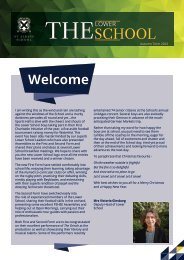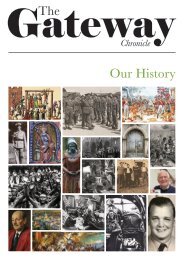Create successful ePaper yourself
Turn your PDF publications into a flip-book with our unique Google optimized e-Paper software.
35<br />
remaining parochial in England until at least the<br />
late-eighteenth century. Even where formalised<br />
medical institutions existed, the caregiving role of<br />
a woman persisted. For example, Broomhall notes<br />
how, ‘women at all levels were involved in treatment<br />
of the sick, and the maintenance of health, within<br />
their family or household’, and this was not something<br />
reserved for a certain section of society. It is<br />
only due to being unrepresented in contemporary<br />
source material that the voices of these women have<br />
Hidden Voices<br />
not been fully considered. Therefore, although the<br />
rise of the man-midwife was certainly a threat to female<br />
practitioners, they certainly did not undermine<br />
the authority of the traditional midwife overnight;<br />
caregiving within the domestic sphere remained the<br />
responsibility of the wife and mother throughout<br />
this period.<br />
Furthermore, recent scholarship has stressed the<br />
fact that any shift away from female midwives was<br />
actually brought about by women themselves,<br />
in response to changing fashions.<br />
If this is the case, then it completely<br />
undermines the argument that women<br />
were the unwilling victims of this shift<br />
towards man-midwives. Adrian Wilson,<br />
for example, believes that ‘this change …<br />
did not arise from any campaign on the<br />
part of male practitioners to displace the<br />
female midwife; … on the contrary, it arose<br />
from new choices on the part of mothersto-be,<br />
and it appears to have taken male<br />
practitioners by surprise’. The reason for<br />
this sudden transition seems to be largely<br />
focused on the rise in civility after the<br />
sixteenth century. With the breakdown<br />
of traditional community relationships,<br />
many women worked harder to distinguish<br />
themselves from people lower down the<br />
social scale. For women, a way of doing<br />
this was through the employment of<br />
the man-midwife in favour of the poorer<br />
female midwife, whose negative reputation<br />
among some of the educated classes<br />
has already been outlined. This shift was<br />
further encouraged with the introduction<br />
of forceps by Peter Chamberlen in the seventeenth<br />
century; although, they did not<br />
become widely used until a century later.<br />
These instruments became fashionable<br />
among the elites, who saw the possession<br />
of medical knowledge and instruments as<br />
a distinguishing factor between themselves<br />
and the poor. However, the role played by<br />
fashion has, however, been questioned by<br />
Sommers who states that, ‘while the fashionable<br />
appeal of the man-midwife may<br />
have played a part in women’s decision to<br />
employ a male practitioner, women and<br />
their families were unlikely to make such<br />
an important a decision solely on this basis’.<br />
Nevertheless, it remains the possibility<br />
that the pregnant mother retained a certain


















